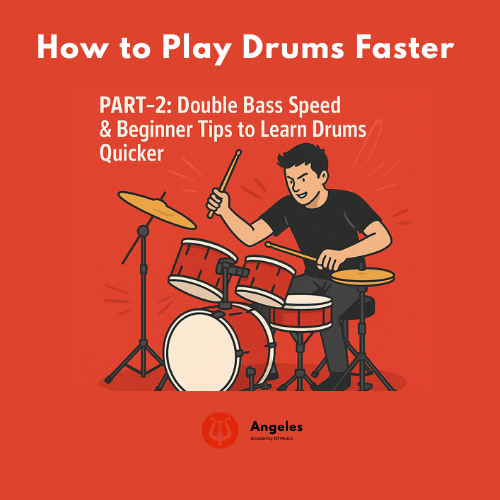
Distance learning is our new reality. At Angeles Academy of Music, we thought our students and parents might enjoy reading a compilation of the best suggestions we could find on how to improve the distance learning experience. This article doesn't only deal with online music lessons, but applies to any subject. If you don’t have children, but you are a college student, or a professional that is spending an increased amount of time in front of your screen, this article may be helpful as well. We know many of you already have great at home setups, but perhaps you can find a tip that will further improve your setup.At the end of this article, we have included a link to a facebook post were we are inviting students and parents to contribute with suggestions and comments. With over three hundred students and more than thirty music instructors, we are looking forward to what might be a very productive chat on this subject.
Mental Outlook
We choose to mention psychology first, because it has such an enormous effect on everything we do. As a large music school in Los Angeles, we have heard from numerous parents that are frustrated and exhausted by the online learning process. Aside from the many physical adjustments that can improve the experience, adjusting the mental outlook on circumstances will also have a powerful effect on the educational results.Although its cliche, seeing the positive will make a huge difference. Phrases like: “Make lemonade out of lemons” and “Bloom where you are planted” Can help to get the most out of distance learning.Aside from the social limitations, zoom fatigue, and multiple other stresses that students and parents are experiencing as a result of distance learning, there may be some positive side effects, such as increase in critical family time, relationships with siblings, new interests discovered, and improved self discipline. All these positives may be focused on to help balance the downsides.
Create a Separate Space
It's important to have a separate space for learning so that students can also get away, and “escape into the real world.”A permanent setup is also important to reduce eye strain, control lighting, improve connection experience and sound quality. Much of what this article suggests can only be accomplished with a designated permanent setup. (Keep in mind if they are taking music lessons virtually, it can help to move their instrument into this space as well).
Exercise/Break
Stretching, and and planing simple physical activities will help to counteract the negative effects of sedentary computer time.Many families are exercising less during these challenges, and as we know there is a direct correlation between exercise and mental outlook. To start, because sitting has such a negative effect on the body, stretching calves and hamstrings, and walking briefly around with intentionally good posture, can help to counter these negative effects. That said, even just stepping away into a different room, taking a breath of fresh air out the window, getting a glass of water, or watering the plants can all make a difference.
Eye Health
As most of you know, long periods of time staring at the screen is really unhealthy for the eyes. Here are some tips that will make a big difference.20/20/20 Rule, recognized by most eye doctors. The advice is when looking at a computer screen, break every 20 minutes, for 20 seconds, and look at an object 20 feet away.Increase your blinking! Studies show that when people look at screens they blink far less than they should. This causes dry, irritated, and often red eyes.Lighting: To reduce eye strain, the lighting in the room should be about half the brightness of a common office. Beware of harsh overhead lighting. Adjust the monitor so that it is close to the same brightness as the room, and ensure that it is at about eye level, (rather than constantly looking down). Watch out for glares, and consider investing in a glare protector if this is an issue. Also, some monitors offer blue light reduction or blocking, and there are a variety of products that can reduce the blue light transmission from the screen.Big Screen: Having a large enough screen is crucial. A good test is that the screen should be at least as far away as your hand if outstretched. This is generally larger than what most people are working on. Purchasing an additional monitor is often a cost effective solution.Improve Video ExperienceVideo quality comes down to your internet connection.We highly recommend that you do not use wifi. Go and purchase an ethernet to usb adapter, (very inexpensive), and plug directly into the wall. The difference is incredible. This alone will alleviate a lot of frustration in the distance learning process. Also, because zoom and other platforms take up significant bandwidth, do not try to stream video on other devices. Ultimately, because the quality of the experience is so greatly affected by the internet speed, consider investing in a more expensive internet service, it may be well worth the cost.In addition to improving the video speed, another suggestion is more phycological with reference to video settings.PIN VIDEOAdjust the setting on your platform to avoid side by side view. (Teacher and Student), Most platforms like zoom, include options to change the size of your own image on the screen, or to "pin" the view of the instructor. (so that it doesn't switch to the back and forth to whoever is speaking). When a student is constantly watching themselves it is hugely distracting. Minimizing the size down to a thumbnail, or removing one's own image entirely will really help to reduce the stress in distance learning.
Audio Quality
Again, another huge factor in the quality of the experience.On zoom for example, you can adjust the advanced audio setting to sometimes improve things. For example, in a music lesson, it may be very helpful for both parties to disable “suppress persistent background noise” as zoom may often categorize the instrument as (background). Purchasing a mic and headphone, or a headset that combines both, is often very helpful as well. Programs such as cleanfeed, and a host of others may also really help to improve the audio quality, and thus the overall educational experience.
Tips for Music Lesson Setup
Although all the above certainly apply to the quality of the music lesson experience as well, there are some specifics that will make a big difference. In general, a laptop is best, or a large ipad with an adjustable stand. For piano, its most helpful in the student sets up the camera from the side, in a similar position to the viewpoint of a teacher. That means about 3 feet above the keyboard height, and looking slightly down. This really helps instructors because they can clearly see keys and fingerings. For all other instruments, the position of the camera should also be thought of as the most natural viewpoint of the instructors. For example, in a seated guitar class, the camera should be around the eye level of the student, looking down at the instrument, and for a standing violin class, again at eye level with the student.Please Share Your Thoughts!At this link below, you will find the posting of this article on facebook. In the comments section, please write a few words about what you have found helpful in improving distance learning. Many parents and instructors will read this and we think the sharing will be very helpful to everyone! Don’t hesitate to share your thoughts on this article as well.Stay safe everyone!Facebook Discussion
.svg)
.svg)
.svg)
.svg)
.svg)
.svg)





.svg)